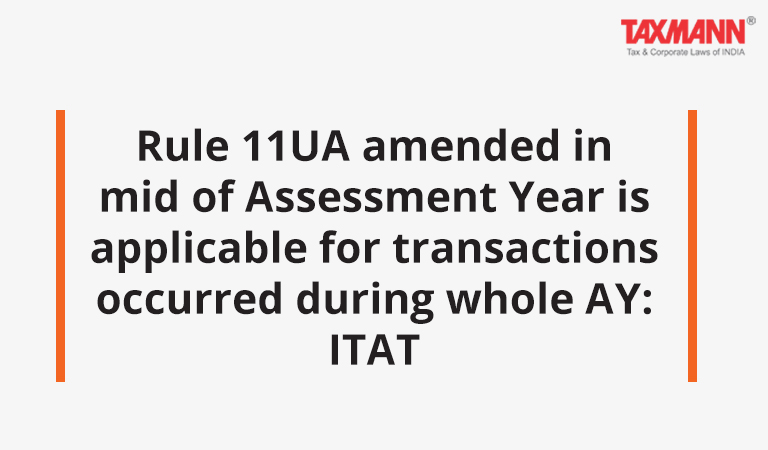Rule 11UA amended in mid of Assessment Year is applicable for transactions occurred during whole AY: ITAT
- Blog|News|Income Tax|
- 2 Min Read
- By Taxmann
- |
- Last Updated on 22 October, 2021

Case Details: UKN Hospitality (P.) Ltd. v. ITO - [2021] 131 taxmann.com 121 (Bangalore - Trib.)
Judiciary and Counsel Details
-
- N.V. Vasudevan, Vice President and B.R. Baskaran, Accountant Member
- S.V. Ravishankar, Adv. for the Appellant.
- Kannan Narayanan, Jt. CIT (DR) (ITAT) for the Respondent.
Facts of the Case
The assessee-company allotted 4,50,032 equity shares of the face value of Rs. 10 at a premium of Rs. 136 per share on 14-8-2021 and received share premium. During the relevant previous year, on 21-11-2012, the assessee issued and allotted 146 shares at very high premium. The assessee followed Discounted Cash Flow (DCF) method for valuation of same.
The Assessing Officer (AO) rejected the assessee’s explanations and contended that the DCF method was permissible only in respect of shares issued after 29-11-2012 when rule 11UA was amended, providing for adopting either DCF or NAV method as the method of valuation of shares for the purpose of section 56(2)(viib). AO accordingly arrived at value under NAV method and brought to tax a sum of Rs. 2.75 Crore.
On appeal, the CIT(A) affirmed the order of the AO. Aggrieved-assessee filed the instant appeal before the Tribunal.
ITAT Held
The Bangalore Tribunal held that the provisions of section 56(2)(viib) were introduced by the Finance Act, 2012 with effect from 1-4-2013, and, therefore, those provisions were applicable. Rule 11UA was amended by Notification No. 52/2012 dated 29-11-2012, whereby the DCF method was an acceptable method of valuation of shares.
Valuation of shares for the purpose of section 56(2)(viib) has to be as on the date of issue of shares. The basis of valuation can be on the basis of a method which is subsequently recognized by the legislature. It cannot be said that valuation is to be made only by the method that prevailed on the date of issue and allotment of shares.
Accordingly, the basis of valuation by the DCF method, which was one of the recognized methods during the previous year relevant to the assessment year 2013-14, ought to have been examined by the Assessing Officer and the Commissioner (Appeals).
Case Review
-
- Vodafone M-Pesa Ltd. v. Pr. CIT [2018] 92 taxmann.com 73/256 Taxman 240 (Bom.) (para 14)
- Agro Portfolio (P.) Ltd. v. ITO [2018] 94 taxmann.com 112/171 ITD 74 (Delhi – Trib.) (para 14) followed.
List of Cases Referred to
-
- VBHC Value Homes (P.) Ltd. v. ITO [IT (Appeal) No. 2541 (Bang.) of 2019, dated 12-6-2020] (para 11)
- Vodafone M-Pesa Ltd. v. Pr. CIT [2018] 92 taxmann.com 73/256 Taxman 240 (Bom.) (para 11)
- Innoviti Payment Solutions (P.) Ltd. v. ITO [2019] 102 taxmann.com 59/175 ITD 10 (Bang.) (para 11)
- Agro Portfolio (P.) Ltd. v. ITO [2018] 94 taxmann.com 112/171 ITD 74 (Delhi) (para 13).
Disclaimer: The content/information published on the website is only for general information of the user and shall not be construed as legal advice. While the Taxmann has exercised reasonable efforts to ensure the veracity of information/content published, Taxmann shall be under no liability in any manner whatsoever for incorrect information, if any.

Taxmann Publications has a dedicated in-house Research & Editorial Team. This team consists of a team of Chartered Accountants, Company Secretaries, and Lawyers. This team works under the guidance and supervision of editor-in-chief Mr Rakesh Bhargava.
The Research and Editorial Team is responsible for developing reliable and accurate content for the readers. The team follows the six-sigma approach to achieve the benchmark of zero error in its publications and research platforms. The team ensures that the following publication guidelines are thoroughly followed while developing the content:
- The statutory material is obtained only from the authorized and reliable sources
- All the latest developments in the judicial and legislative fields are covered
- Prepare the analytical write-ups on current, controversial, and important issues to help the readers to understand the concept and its implications
- Every content published by Taxmann is complete, accurate and lucid
- All evidence-based statements are supported with proper reference to Section, Circular No., Notification No. or citations
- The golden rules of grammar, style and consistency are thoroughly followed
- Font and size that’s easy to read and remain consistent across all imprint and digital publications are applied




